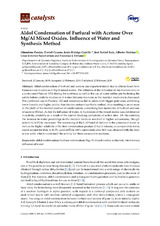Aldol Condensation of Furfural with Acetone Over Mg/Al Mixed Oxides. Influence of Water and Synthesis Method
Autor
Parejas, A.
Cosano, Daniel
Hidalgo-Carrillo, J.
Ruiz, José Rafael
Marinas, Alberto
Jiménez-Sanchidrián, César
Urbano Navarro, Francisco José
Editor
MDPIFecha
2019Materia
Aldol condensationBiomass valorization
Mg/Al mixed oxides
Surfactant
Microwaves
Influence of water
METS:
Mostrar el registro METSPREMIS:
Mostrar el registro PREMISMetadatos
Mostrar el registro completo del ítemResumen
Aldol condensation of furfural and acetone (an important initial step to obtain diesel from biomass) was studied over MgAl mixed oxides. The influence of the utilization of microwaves and/or a surfactant (Pluronic 123) during the synthesis as well as the use of water (either pre-hydrating the solids before catalytic studies or in water/toluene mixtures as the reaction medium) is discussed. The combined use of Pluronic 123 and microwaves led to solids with bigger pore sizes, exhibiting lower basicity and higher acidity than the conventional synthetic method, thus resulting in an increase in the yield of the desired product of condensation, comprising two molecules of furfural and one of acetone (F2Ac). As for the influence of water, re-hydration of the mixed oxides was detrimental to activity, probably as a result of the partial blocking (solvation) of active sites. On the contrary, the increase in water percentage in the reaction medium resulted in higher conversions, though selectivity to F2Ac decreased. The weakening of the C=O bond of furfural in the presence of water as well as the higher solubility of the first condensation product (FAc) in toluene, as compared to water, could account for that. A 44.5% yield of F2Ac (66% conversion) after 16 h was obtained with the most active solid, which maintained the activity for three consecutive reactions.

